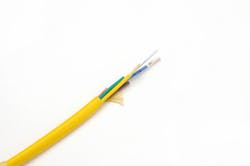Berk-Tek’s singlemode OneReach cable assembly (OCA)
Berk-Tek’s Singlemode OneReach Cable Assembly (OCA) combines OS2 optical fiber and copper conductors in a single assembly that quickly attaches with standard M8 and LC or MPO connectors, taking PoE up to 8200 feet per singlemode 1-port device. The OCA is composed of CL3P-OF or CL3R-OF -rated PLTC-OF composite copper/fiber cables that support power and data transmission within a single jacket. These cables combine 12-AWG conductors with either tight-buffered or loose-tube optical fiber cable designs for flawless data transmission, says the company. Key benefits of the cable include the following: simple, single-pull installation; Berk-Tek-enhanced SMF compliant with ITU-T G.652.D and ITU-T G.657.A1; cable provides common pathway for fiber backbone and Class 2 or 3 power supply. For the fastest deployment, the OCA can be built to the specific length requirements of each project and arrive ready-to-install onsite, with pretested optical fiber connectors and an M8 connector for power on the remote device end.
Berk-Tek, berktek.com
4-port media converter with integral power
The NetWaySP4P headend Ethernet-to-fiber rackmount media converter accommodates singlemode or multimode fiber and is an ideal way for composite cable (fiber + copper) to simultaneously deliver low-voltage power and data at greater distances. The unit is also equipped with battery charging for applications requiring backup. For remote deployment where local power is not an option, power and data can be delivered from the NetWaySP4P to a wide range of Altronix NetWay Spectrum hardened PoE+ switches, such as the NetWay4EWP, with SFP ports and up to 8 PoE ports for powering multiple IP devices. All products in the NetWay Spectrum series are made in the United States.
Altronix, altronix.com
Power+ Composite fiber-copper cable
The Power+ Composite cables from Hitachi Cable America are an optimal solution for extending power and connectivity to remote devices. Ideal applications include security cameras, WiFi access points, distributed antenna systems (DAS) and small cells, passive optical networks (PON) and other devices/applications requiring a network connection and power less than 60VDC SELV (safety extra low voltage). The Power+ Composite series can support 25.5 watts of power up to 2,700 feet. With either singlemode or multimode optical fibers and copper gauges from 12 to 22, the Power+ Composite cables utilize a construction that is both plenum-rated for indoor use and also designed for outdoor use, thus eliminating the need to transition from outdoor-rated cable to indoor-rated cable, a requirement of the National Electrical Code. Made in the United States at the manufacturer’s Manchester, NH facility, the Power+ Composite series is suitable for lashed aerial, duct, underground conduit and all indoor applications.
Hitachi Cable America, www.hca.hitachi-cable.com
Corning’s ActiFi composite cable
Customers can easily leverage the benefits of fiber and power with Corning’s ActiFi Flame Retardant Composite Cables. Available in bulk or reel-in-a-box packaging, this cable provides an ideal solution for indoor remote powering of distributed antenna systems, optical networks, small cells and more, says the company. The cable’s design uses Corning optical fiber for data transmission and linear laid copper conductors for remote powering. Corning’s ActiFi cables are rated at 300 VAC and are suitable for use with Digital Electricity and +/-190VDC installations in accordance with NEC Article 830.15. The cables may also be used with low-voltage installations in accordance with NEC Article 725 Class 3. By eliminating separate power and fiber cable runs, this cable can reach farther distances, while saving costs on multiple fronts.
Corning, corning.com
Micro Armor fiber-optic cable with 2 power cable conductors
TiniFiber’s Micro Armor Fiber-Optic Cable with 2 Power Cable Conductors defines a powered fiber cable system (PFCS). This hybrid fiber-optic cable with power cables is available in either singlemode or multimode configurations with electrical conductors. The “power cables” can be of either 2, 3 or 4 conductors with 12 AWG to 22 AWG options. The cable’s basic construction is two strands of singlemode fiber with 18 AWG/2 conductors all under one outer jacket. Using the company’s Micro Armor fiber technology, the outer diameter (OD) of this cable is minimized, enabling efficient use of space and materials. The fiber-optic cable can consist of armored strands from 1 to 24 fiber strands. TiniFiber fiber-optic cables are available in multiple jackets for plenum, riser, LSZH, harsh environments and outdoor-rated options to meet all project needs.
TiniFiber, tinifiber.com
Belden’s Digital Electricity cables
One version of Belden’s Digital Electricity Cables is a copper/fiber hybrid construction that the company explains helps installers reduce cable inventory. It requires only one cable stock to manage, and reduces labor costs with only a single cable to pull, Belden said. The company designed the cables in conjunction with VoltServer, recognized as the creator of Digital Electricity. The cables are available as shielded or unshielded constructions, in pairs of two, four, or eight, and in conductor sizes of 14, 16, or 18 AWG. They can transmit up to 2,000 watts of power, or up to 2 kilometers in reach. The company points out that one application that Digital Electricity can support is in-building wireless, such as distributed antenna systems. “Often, the ideal location for a DAS radio isn’t near a local power source, and this is driving the need for Digital Electricity,” Belden says.
Belden, belden.com





